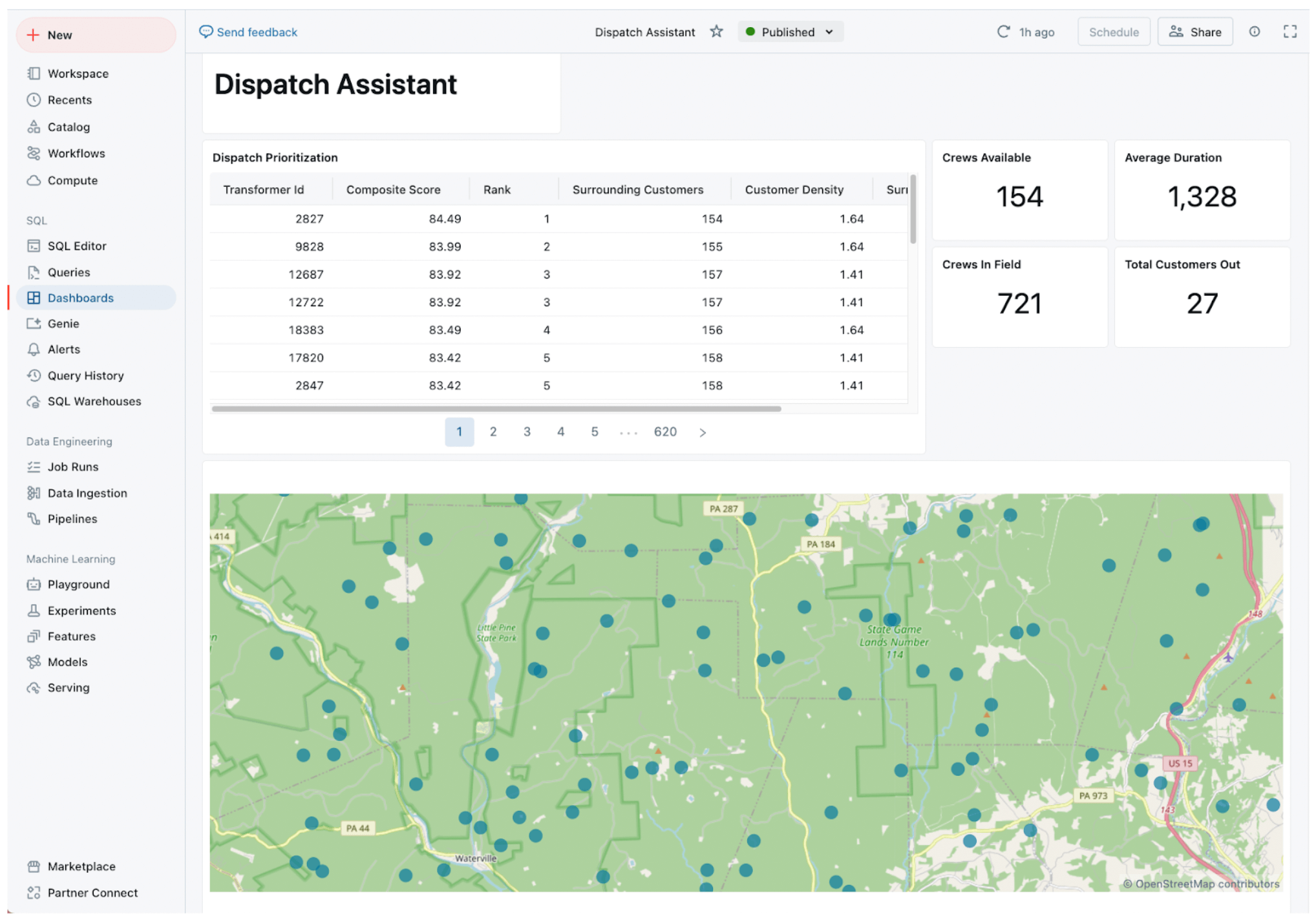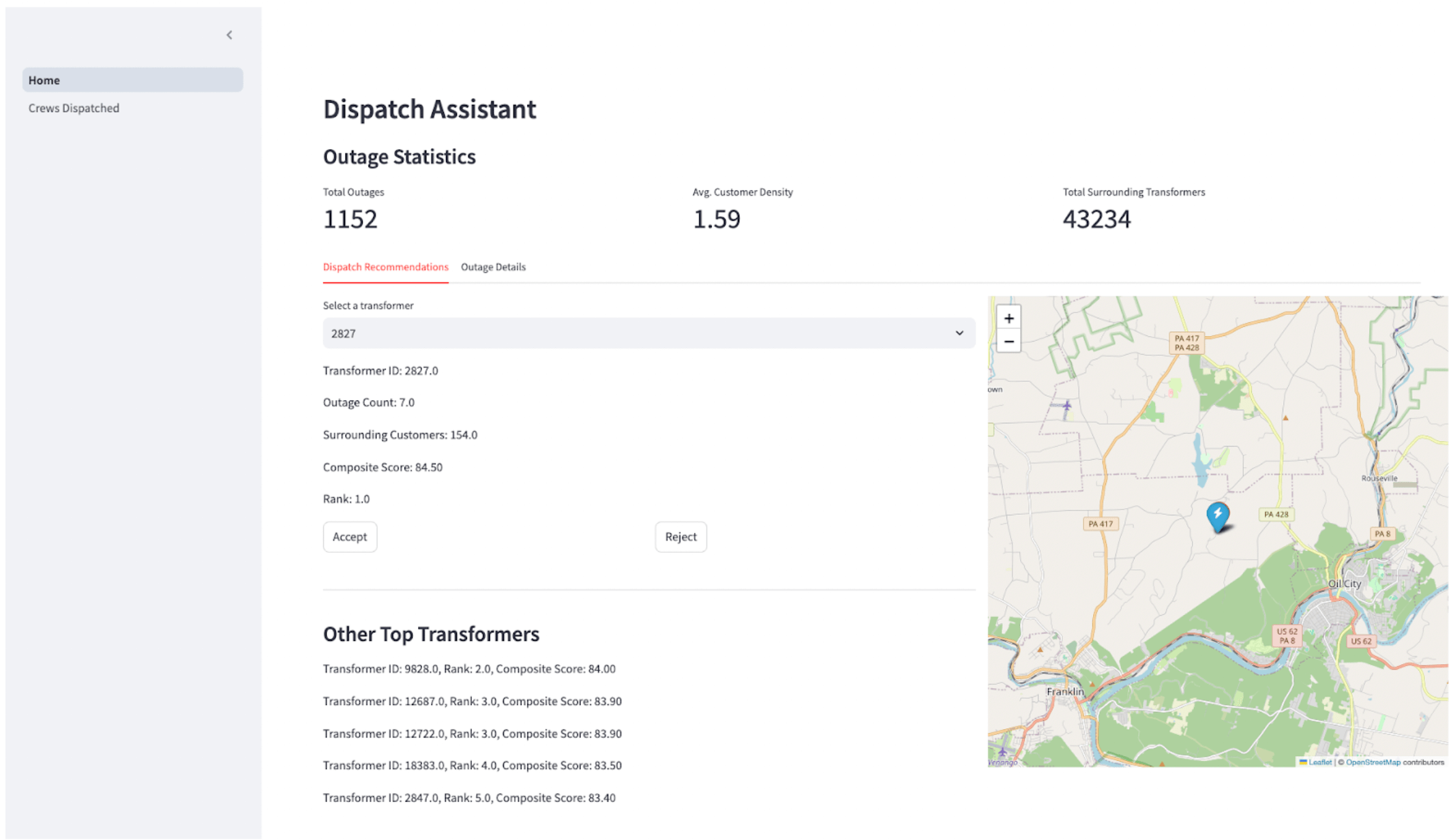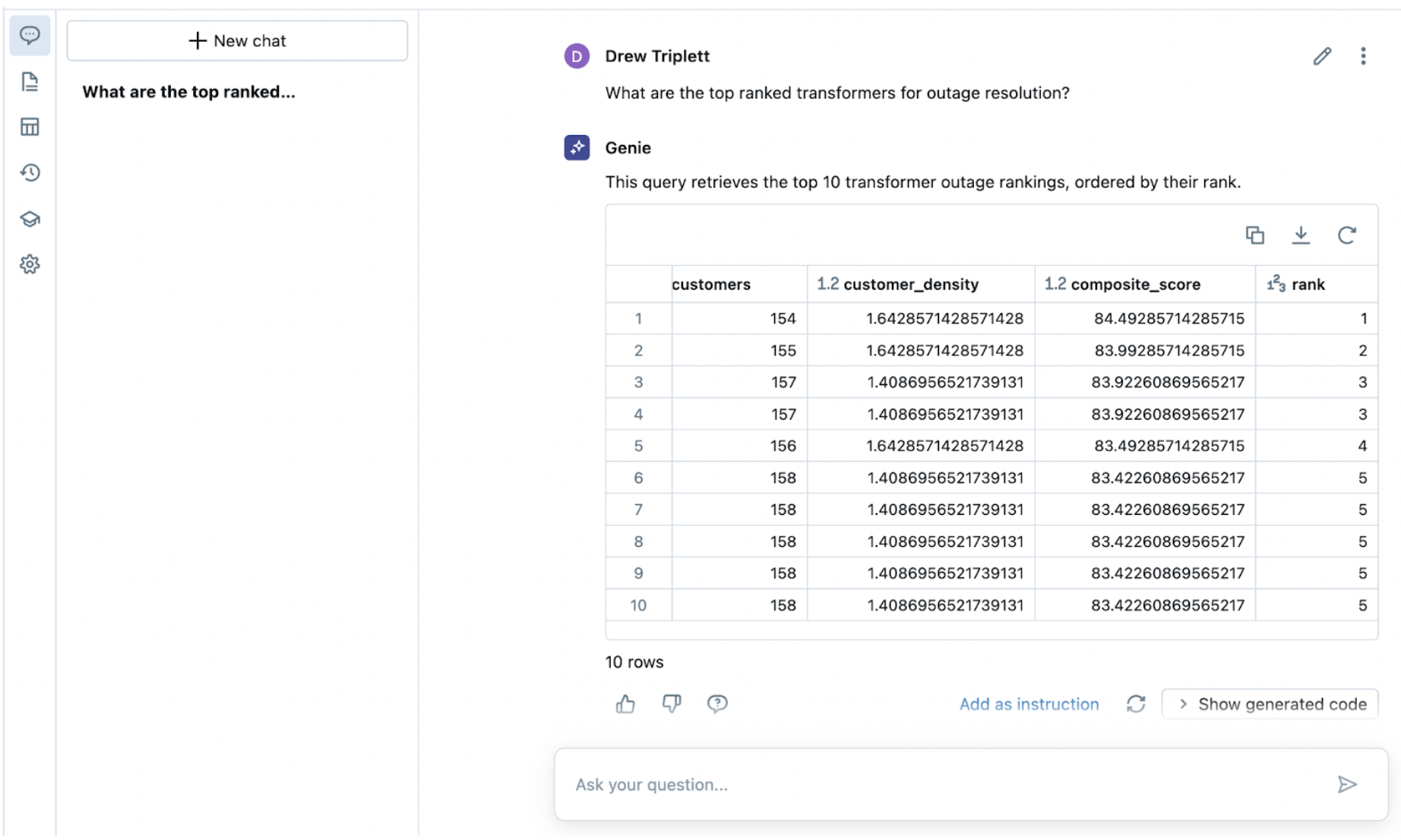In today’s fast-paced world, utility companies face numerous challenges when it comes to outage response and restoration, especially during severe weather events. The Dispatch Assistant aims to transform how utilities handle these critical situations. This is increasingly important since over the past couple of decades there have been a significant increase in both the frequency and intensity of storms across various regions. According to NOAA, there were 28 weather and climate disasters in 2023, surpassing the previous record of 22 in 2020, tallying a price tag of at least $92.9 billion. These disasters make it increasingly more challenging to keep power grids online and are a big cost element in post-disaster clean up and recovery. This is driving utilities to look more towards the power that AI can provide in all facets of their business.
The Challenge of Restoration Prioritization
In recent years, utility companies have faced increasingly complex challenges when responding to outages caused by extreme weather events. As storms become more frequent and intense, the need for efficient and effective response strategies has never been greater.
One of the primary hurdles utilities face is optimizing limited resources during large-scale outages. With a finite number of repair crews and equipment, companies must make difficult decisions about where to allocate their assets. To address this, many utilities are turning to advanced workforce management systems and predictive analytics. These tools help optimize crew assignments based on skills and location, while also anticipating equipment needs before storms hit.
Balancing critical needs against widespread outages is another crucial aspect of storm response. Utilities must prioritize between restoring power to essential infrastructure like hospitals and addressing outages affecting the largest number of customers. To tackle this challenge, utilities are developing clear prioritization frameworks and some even utilizing real-time data to dynamically adjust their strategies as conditions change (SPOILER ALERT: this is what we will be addressing today with Dispatch Assistant).
Accurate damage assessment is vital for effective resource allocation, but it can be challenging during extreme weather events. To improve this process, utilities are increasingly deploying drones and other advanced technologies for rapid, remote inspections. Some are even implementing AI-powered image analysis to quickly identify and categorize damage.
Communication with stakeholders is another critical component of outage response. Customers, regulatory bodies, and internal teams all require timely and accurate information. To meet these needs, utilities are implementing multi-channel communication systems and automated messaging to provide regular, personalized updates to affected customers.
The unpredictable nature of extreme weather events requires utilities to be highly adaptable. Storm paths can shift unexpectedly, and secondary weather events can create new challenges. To improve their agility, many companies are implementing advanced weather forecasting systems and developing flexible, scenario-based response plans.
By addressing these challenges through a combination of advanced technologies, improved planning, and enhanced communication strategies, utility companies are working to significantly improve their outage response capabilities. While the task remains daunting, these efforts are leading to faster restoration times, improved customer satisfaction, and more efficient use of resources in the face of increasingly severe weather events.
The Dispatch Assistant Solution Accelerator
In the world of utility management, responding to power outages quickly and efficiently is crucial. Enter the Dispatch Assistant, a game-changing tool that’s transforming how utility companies handle outage response. The Dispatch Assistant, powered by Databricks’ Data Intelligence Platform, can significantly improve the ingestion, processing, and analysis of the vast amounts of operational data required for optimal outage response. Databricks’ platform is uniquely suited to handle the high-frequency sensor data emitted by utility assets, processing millions of data points per piece of equipment
At its core, the Dispatch Assistant is a smart system that ingests a wide array of operational data. This includes everything from AMI outage alarms and network topology information and in the future could expand to include other data assets such as weather data and maintenance records. But it’s what the system does with this data that makes it truly remarkable. The platform’s real-time data processing capabilities, such as Delta Live Table’s Streaming Table, and Materialized View capabilities, are particularly valuable for the ingestion and processing of this operations data.
Once ingested, Databricks’ Unity Catalog enhances the Dispatch Assistant’s data management capabilities, ensuring robust governance and compliance for sensitive utility information. It provides fine-grained access controls across various data levels, from catalogs to individual columns and rows, ensuring personnel only access necessary data. The catalog’s data discovery features enable quick location and understanding of relevant datasets, improving decision-making efficiency during outage responses. Automated lineage tracking offers valuable insights for audit trails and impact analysis, while the unified security model simplifies administration and facilitates secure data sharing. These features collectively enable the Dispatch Assistant to maintain data integrity, security, and regulatory compliance while optimizing utility operations. By leveraging Unity Catalog, the Dispatch Assistant can effectively manage and utilize sensitive data, adhering to industry standards and data protection regulations.
Combining Geospatial and Operational Data to Enhance Restoration Prioritization
Dispatch Assistant processes this enables dispatcher decision making through a sophisticated recommendation engine. This recommendation engine builds on top of a utility’s existing aggregations to roll-up outages within the outage management system (OMS) and combines it with geospatial distancing to generate recommendations. This is accomplished by taking outage incidents and using h3 indexing to identify outage incidents that are geographically close. H3 indexing is a hierarchical, hexagonal grid system that divides the Earth’s surface into cells of varying resolutions. Each cell is assigned a unique 64-bit identifier, allowing for efficient spatial analysis and aggregation of data across different scales. By leveraging H3 indexing, the Dispatch Assistant can quickly group nearby outages, enabling more effective resource allocation and response prioritization.
Using the h3 indexing to match outages that are close in proximity enables aggregation and density metrics calculations to ultimately know the impact of sending a crew to a particular area. These metrics are then used to score and ultimately rank the outages for a dispatcher to use for crew assignment. The ranking algorithm combines customer outage density within H3 cells and the geospatial distance between outage events to create a comprehensive priority score. This approach ensures that areas with high concentrations of affected customers are prioritized, while also considering the efficiency of crew movements between nearby outages. By weighting these factors, the system can optimize crew assignments to maximize the number of customers restored in the shortest possible time, balancing the need for rapid response with logistical efficiency.

Serving Insights to Dispatchers to Improve Restoration Outcomes
The result? Optimal crew dispatch decisions suggested in real-time. These recommendations are presented in an easy-to-understand format, allowing dispatchers to make informed decisions quickly and confidently. Moreover, the Dispatch Assistant’s outputs can be seamlessly integrated into a comprehensive AI/BI dashboard. This dashboard provides a holistic view of utility operations, combining real-time dispatch data with other key performance indicators. Utility managers can use this unified platform to track outage response times, crew efficiency, and overall system reliability, enabling data-driven strategic planning and continuous operational improvement.

Furthermore, Databricks Apps offers an even more interactive experience, enhancing the functionality of Databricks. This new feature allows for the creation of a comprehensive, one-stop solution for dispatchers. With it, dispatchers can seamlessly accept recommendations and automatically push jobs to downstream systems for crew assignment and scheduling, streamlining the entire process. This provides a more seamless experience over traditional use of dashboards for serving insights that then require another tool for taking action. Additionally, this provides a less complex solution than creating a custom web app from scratch.
Databricks Apps leverages the power of the underlying Databricks Data Intelligence Platform to provide a seamless development and deployment experience. It utilizes serverless compute resources, automatically provisioning and scaling the necessary infrastructure to run applications efficiently. This eliminates the need for developers to manage complex infrastructure setups, allowing them to focus on building and iterating their apps.
Databricks Apps integrates tightly with Unity Catalog, enabling robust data governance and access controls. This integration ensures that applications adhere to organizational data policies and security requirements without additional configuration. The platform also supports popular Python frameworks like Dash, Shiny, Gradio, Streamlit, and Flask, allowing developers to use familiar tools while benefiting from the scalability and performance of the Databricks environment.

The resulting dataset from the Dispatch Assistant’s operations can also be leveraged to power a Genie Room focused on outage management and crew dispatch optimization. This immersive environment would allow dispatchers and other internal stakeholders to easily query the underlying data or resulting data from the recommendation engine using natural language questions. By integrating live data from the Dispatch Assistant, the genie room could offer interactive visualizations of ongoing outages, crew locations, and asset restoration prioritization, enabling more informed and agile decision-making during critical incidents.

Conclusion
The impact of this solution on utility operations is significant. By optimizing crew dispatches, companies can restore power to more customers faster and more cost-effectively. This not only reduces operational costs but also leads to improved customer satisfaction – a win-win for both the utility and its customers. The Dispatch Assistant’s ability to process real-time data and provide actionable insights allows utilities to respond more proactively to potential outages, often addressing issues before they escalate into major disruptions. In the future, the tool’s advanced analytics could be expanded to identify patterns in outage occurrences, enabling utilities to prioritize maintenance and infrastructure upgrades in areas prone to frequent disruptions. This solution could also feed into an agentic AI system that drives more automation around this complex multifaceted problem, particularly during storm events. The Dispatch Assistant solution lays the foundation for these future advances and is only scratching the surface for potential to move from a reactive way of working to proactive. Ultimately, this proactive approach not only enhances system reliability but also contributes to long-term cost savings by reducing the frequency and severity of outages over time and drives a better experience for all.
Visit The Databricks Energy industry page to learn more.
Source link
lol

